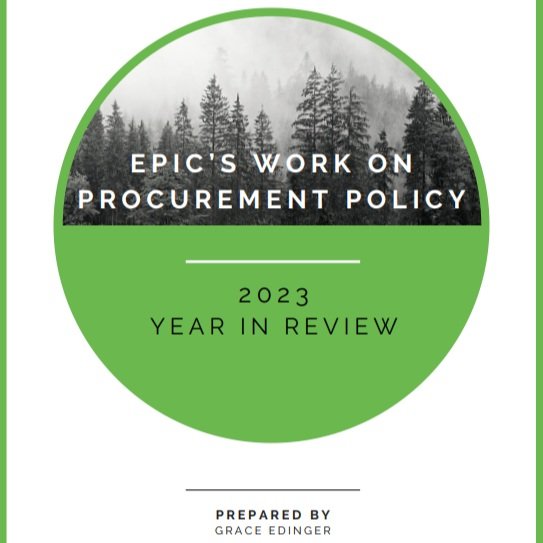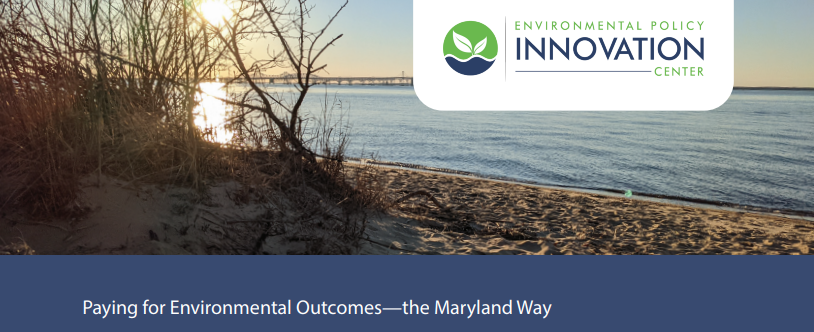Procurement doesn’t need to be a chokepoint.
Our government’s default contracting practice is over one hundred years old. With innovations in technology, advancements in finance, and the need for fast environmental progress, we need to rethink how we structure contracts in a way that works in service of nature and public health.
This system is slow and costly. We aim to cut taxpayer expenses and the time it takes to carry out restoration projects by half.
EPIC works diligently to assist government in moving away from the traditional ‘Design-Bid-Build’ contract and adopting the innovative ‘Pay for Success’ model.
Pay for success allows the government to buy actualized environmental outcomes, just like they already buy office supplies. This type of contract has the potential to generate faster and cheaper environmental outcomes, like pounds of nutrients removed from a watershed, acres of riparian forest buffers planted, linear feet of stream restored, or acres of habitat.
The majority of payment isn’t issued to the contractor until after the project deliverables have been verified and deemed successful.
Examples of Pay for Success Initiatives
-
The 2017 Clean Water Commerce Act was originally designed to fund the most cost-effectiveness upgrades to wastewater treatment plants, but in 2021 the concept was dramatically improved to buy water quality improvement outcomes from other kinds of green infrastructure, including on agricultural lands. Now, this groundbreaking program has been authorized through 2030 to purchase $20 million a year of the most cost-effective nitrogen reduction outcomes. By focusing on outcomes, this program can bypass the typical bottleneck of NRCS technical assistance that has led to frustratingly long wait times for farmers who want to conduct conservation. It will allow the state to scale proven solutions for preventing nitrogen from entering streams, rivers, and the Chesapeake Bay. Maryland Department of the Environment’s application period closed on September 9, 2022, and they received applications for almost five times the amount of money available, most at a significantly lower cost than traditional cost-share or reimbursement contracting.
-
Pennsylvania has long struggled to reconcile its impact on the Chesapeake Bay with its lack of direct access to the estuary. 2022 saw a breakthrough in this paradigm with passage of the $225 million Clean Streams Fund, funded by the American Rescue Plan. Within this Fund, $22.5 million is allocated to the Clean Water Procurement Program, which will buy nitrogen, phosphorus, and sediment reductions much like Maryland’s Clean Water Commerce Act. These quantified units of environmental improvement will be paid for after they are produced, as goods rather than services.This contracting structure will cut paperwork for providers and increase competition, thus driving down costs and allowing for greater restoration benefits. The administering agency, PENNVEST, released a draft application and a scoring system that prioritizes applications based on their cost per pound, inclusion of small farms, and environmental co-benefits in February 2023 and has a request for proposals open until September 1, 2023.
-
Pennsylvania is so crucial to the Chesapeake watershed because of the Susquehanna River, which provides 55% of the fresh water entering the Bay and whose watershed reaches all the way into New York state. Much of the sediment (and the nutrients that come with it) flowing through the Susquehanna was expected to be trapped behind the Conowingo Dam, but as those predictions have been updated, the states now need to find another way to prevent 1.675 million pounds of nitrogen from flowing into the northern reaches of the Chesapeake Bay. To address this, Maryland–on January 4th–approved a $25 million transfer to the multi-state Susquehanna River Basin Commission to buy nitrogen reduction outcomes using Pay for Success contracts in either state’s portion of the watershed. To our knowledge, this represents the first time Maryland will spend state money on projects in another state in the watershed. This collaboration is only enabled because of the clear, quantified environmental outcomes provided by Pay for Success contracts.
-
To many professionals in the restoration field, North Carolina is viewed as the progenitor of environmental Pay for Success. The state’s Division of Mitigation Services in-lieu fee (ILF) programs purchase environmental outcomes to enable environmentally responsible economic development. These state-wide programs are designed to help both private and public entities meet stream and wetland mitigation requirements under the federal Clean Water Act, using a watershed approach to maximize the environmental returns of mitigation investments.
In-lieu fee programs aggregate funding from permittees (e.g., private companies, transportation agencies, etc.) who need to offset their impacts to wetlands, streams, riparian buffers, or water quality. Funds are used to carry out restoration projects in the same watersheds (Huc8 in this case) in which the impacts are occurring. Because ILF programs aggregate funding, they can create larger and more ecologically beneficial restoration than one-off restoration projects. ILF restoration credits also transfer legal liability of restoration success from the permittee to the ILF program.
North Carolina’s decades-strong programs have restored and/or protected over 4.2 million feet of stream and 29,000 acres of wetlands, allowing the creation of over 7,000 development projects like community infrastructure and housing developments. When stream or wetland credits are unavailable from mitigation banks in an area, a permittee can submit a request for mitigation from the state ILF. After collating these requests, the DMS determines where and how much mitigation is needed.
-
Anne Arundel County’s Bureau of Watershed Protection & Restoration (BWPR) implemented the Full Delivery of Water Quality Improvements (“Pay-for-Success” or “PFS”) Program in 2018 to expedite the process of restoring local waterways through public-private partnerships. This program, which funds contracts to private firms that result in the construction of cost-effective stormwater Best Management Practices (BMPs), has become a pillar in the County’s progress toward the goals of its NPDES MS-4 permit, the Chesapeake Bay TMDL, and the EPA Clean Water Act. The PFS Program has created a resilient and cost-effective pipeline of restoration projects that ensure the County’s local tax dollars are being invested towards a sustainable future. Innovative public-private partnerships facilitated by the program help to expedite the process of restoring Anne Arundel County’s waterways.
Not only has this shift in contracting resulted in significant progress towards Anne Arundel County’s goals and permit requirements, these projects are significantly cheaper than previous contracts under traditional structures.
The key to this program is that contractors front the initial cost of implementation, and then are reimbursed by the County after the project is constructed and verified to be effectively generating water quality credits. Competitive proposals are prioritized based on readiness for construction.
-
EPIC, alongside a variety of stakeholders including the US Forest Service and the Chesapeake Bay Trust, developed a fund model using Pay for Success that would help the Chesapeake Bay reach their riparian forest buffer planting goals.
To learn more, please read our Business Plan, Buyer’s Guide, Overview Handout, and Overview PowerPoint.
This model has not yet been implemented. If you, or someone you know, might be interested in moving this idea forward, please email Phoebe Higgins at phiggins@policyinnovation.org
Are you interested in additional examples? Do you want to see what’s going on in your area? We’re actively compiling a database of Pay for Success and Streamlined Permitting efforts nationwide.
Are you a government employee interested in diving into alternative contract structures? A great place to start is to learn about how Pay for Success contracts work. Our Pay for Success 101 Resource Guide can help.
Our team is happy to talk through the ins and outs of government procurement. Contact our Procurement Strategy Lead, Grace Edinger, to set up a call.










































